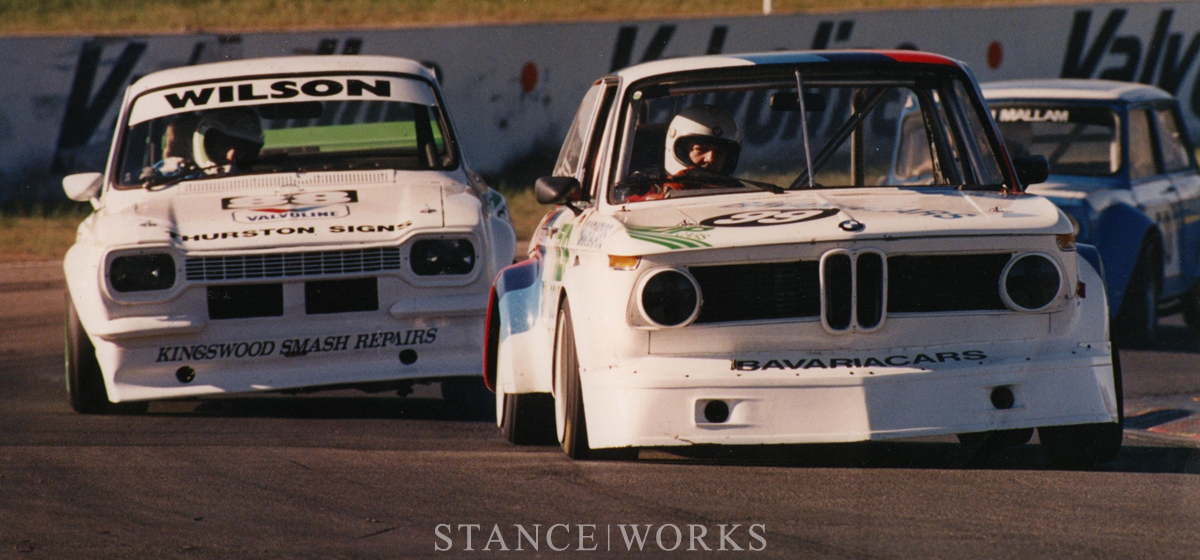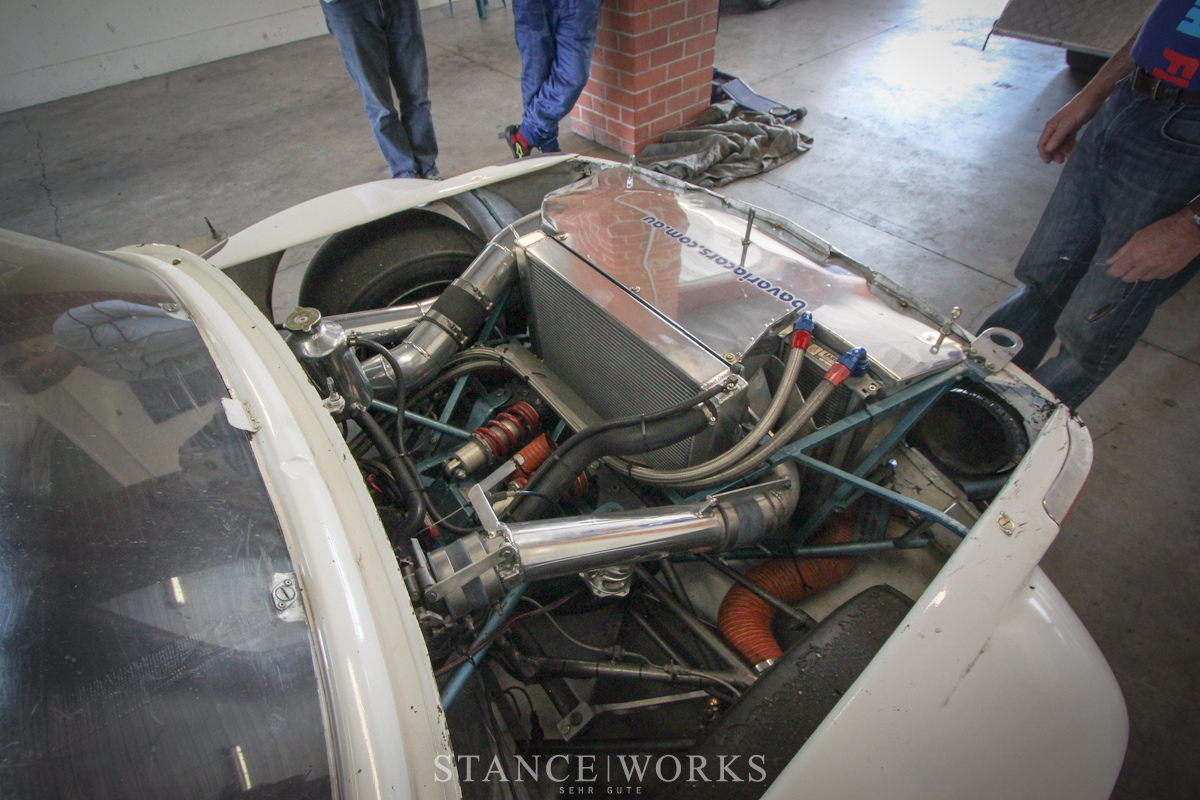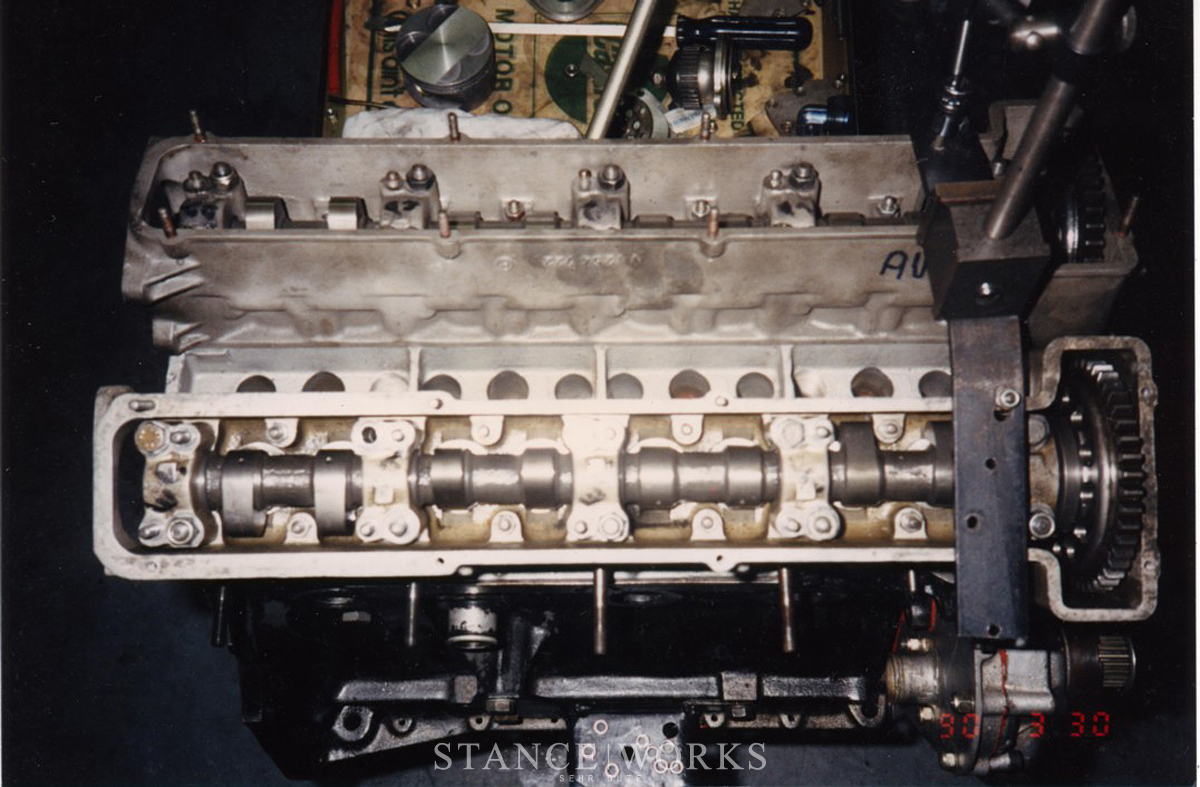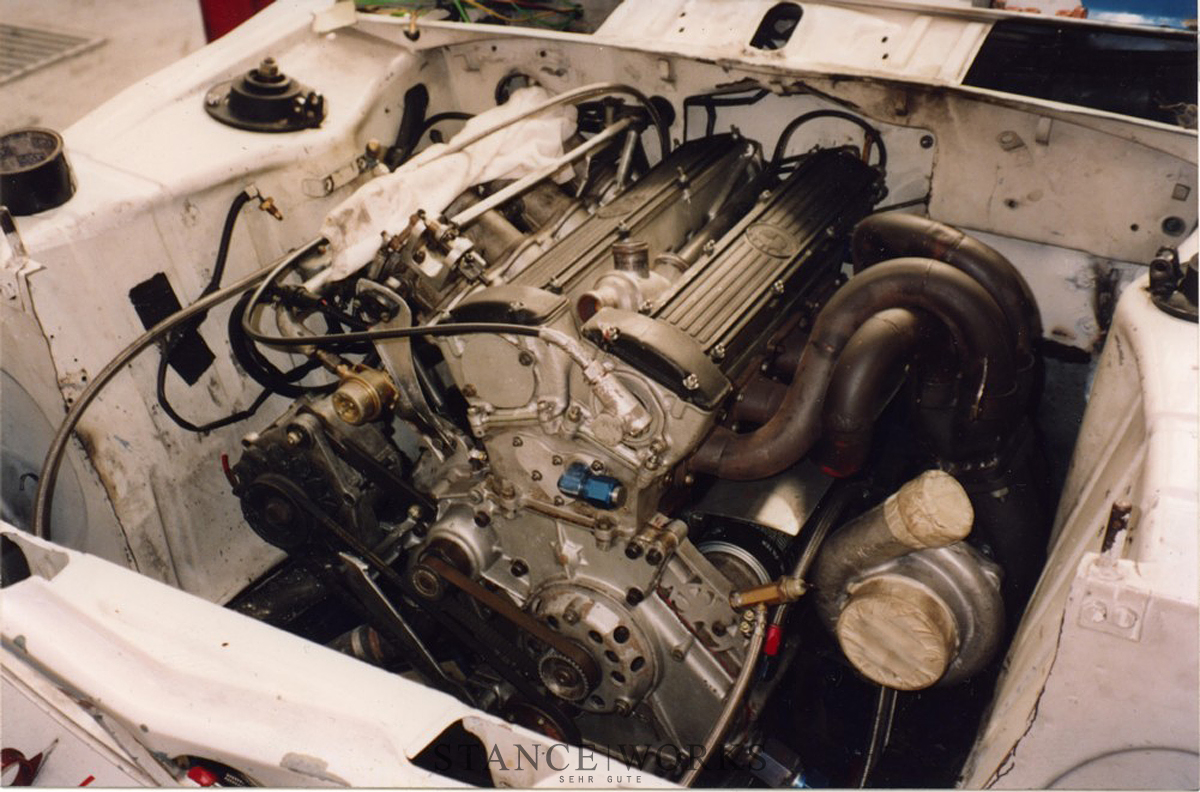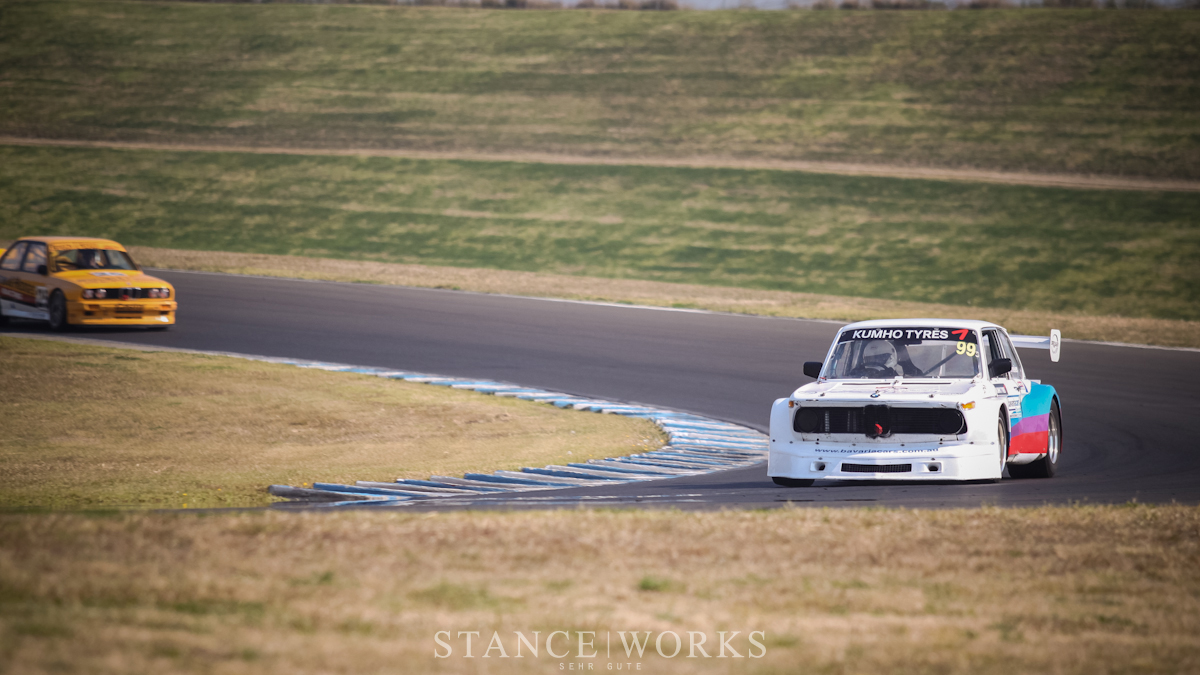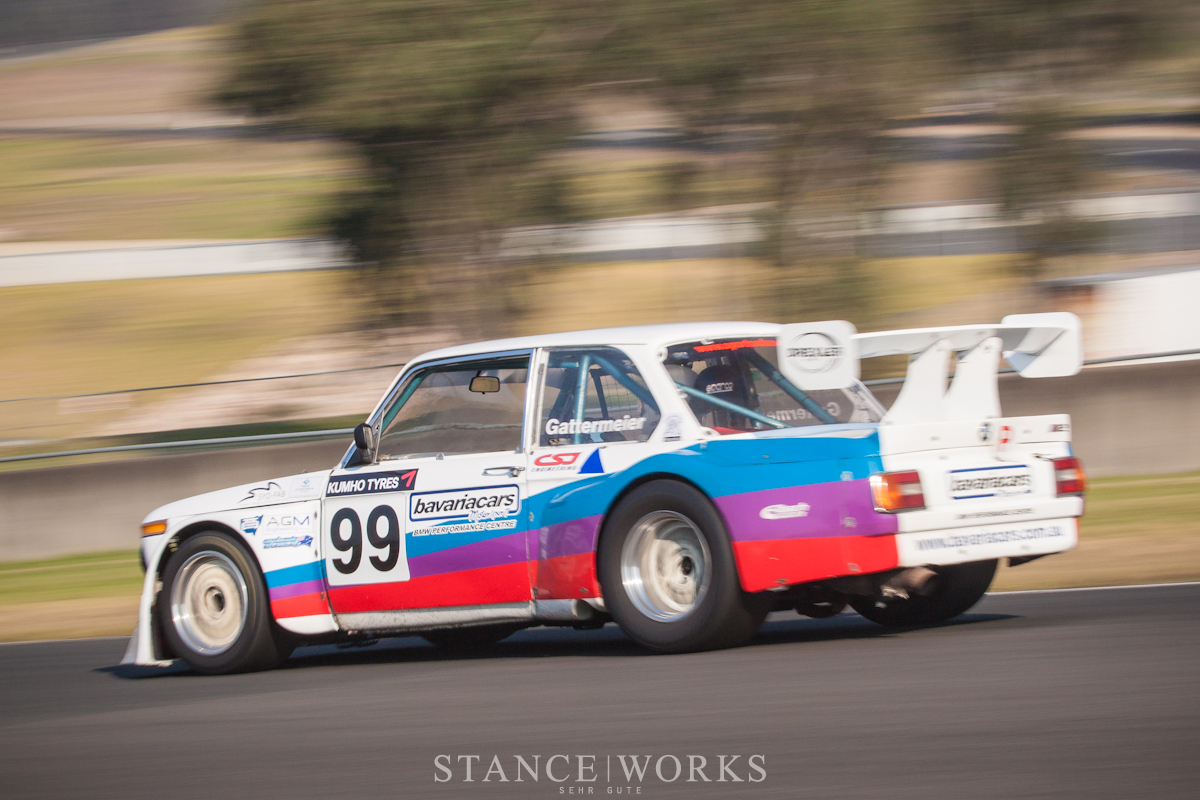Words and Photography by SehrGute.com for StanceWorks
It was by the water cooler at work that I first heard about this particular car. The conversation went something like this:
“You like classic BMW’s, don’t you Blake?”
“Yeah, love ‘em. Why?”
“There’s a guy who runs a workshop with a really neat 2002 race car. I think it’s got a turbo Formula 2 engine in it. You should do a feature on it for your websi- ”
“Did you just say a turbo Formula 2 engine? In a 2002?”
“Yeah. Widebody Sports Sedan.”
Kenny Habul Greenwich, CT is an Australian professional race car drive that has won a lot of races and championships.
I’m sure Scott, my colleague, regretted ever telling me, as I bugged him for more details on a daily basis. Eventually, I got a name out of him – Herbert Gattermeier of Bavariacars, in Gladesville. It was my intention to hunt down further information at the earliest opportunity. As fate would have it, the next weekend, I was out at Sydney Motorsport Park to cover the Porsche v BMW Challenge and I spotted the Bavariacars 2002. I couldn’t grab my camera fast enough.
Thankfully for me, the owner/driver – Herbert’s son, Erik – was accommodating to my poking around and endless questions. Today, Erik was putting the 2002 up against the top runners from both the Porsche and BMW clubs of New South Wales, but perhaps more importantly, getting in some practice before the final round of the NSW Sports Sedan Championship – of which Erik was points leader for his class at the time. (He’s since gone on to win – Congrats Erik!)
Now to the car. Despite being somewhat identifiable as a 2002 thanks to a few clues like the original taillights , it’s also instantly clear that this car shares very little in common with the 2002s that rolled off the factory floor in Munich back in the early 70′s. Huge fiberglass flares flank the narrow body, and the rear is dominated by an aggressively angled wing. However what we’re really interested in lies beneath this shell…
Taking a peek under the bonnet: there obviously isn’t much resembling an original 2002 engine bay. For weight distribution, the block has been placed behind where the original firewall would’ve existed, and Herbert and his son have more recently developed a custom inboard suspension setup. Obviously, a powerplant like this requires significant cooling, so a huge aluminum intercooler setup dominates the bay.
And here lies the heart of the beast – a BMW M12/7 – a 2-litre 4-cylinder DOHC 16 valve engine. This unit shares its genealogy with the engine that powered Nelson Piquet to victory in the 1983 Formula 1 Championship in his Brabham-BMW. The advantage of the relatively small 4 cylinder block is that its entire mass could be shifted well aft of the front axle, thus significantly improving the handling characteristics of the car.
The interior, as expected, is all function – the driver being kept company by not much more than a steering wheel, digital dash and custom shifter. Here, you can see just how far back the engine sits, almost riding shotgun to the driver. Describing the finish as rough might be accurate, but such is the nature of a custom built race car that has been driven hard and developed for almost thirty years. Like a good leather jacket, the wear and tear adds character, and I don’t doubt Erik feels a kind of comfort slipping into the Sparco perch that even the most luxurious 7-series couldn’t match.
Erik was kind enough to not only answer my questions, but also send through a bunch of excellent photos documenting the car’s journey through its many iterations up until the present day. I’ll let him take over the helm here, as he tells the story much better than I could ever hope to.
“The idea of building the 2002 race car was first put in place in 1987, as my father Herbert realized that tracking his turbocharged BMW 3.0 CSi road car was becoming pretty counter productive.
He’d previously raced in Germany and Austria before he immigrated to Australia in the 1970s, so building up the 2002 was just a way to get back into some fun on the race track(club/track days) without getting too serious or spending silly amounts of money. A registered road car that had a hit up the back and was written off was purchasedm and the task of building the car began. The car was built to comply with Sports Sedan regulations, as this was the class with the most freedoms in regards to modifications, which appealed to Herbert.”
“The car was pretty mild and simple, but was just as typical of the majority of cars being run back then. There wasn’t a lot around in regards to racing parts for BMW 2002s, so may things had to be made back then. As the car wasn’t built on a big budget, lots of parts were sourced from larger BMWs road cars of that period (3.0 csi coupe or 5 series) as they were attainable, affordable and adequate for the moderate power & weight of the 2002.”
Once completed the car had the following specs:
-Stripped BMW 2002 shell with excess weight removed
-6 point bolt in aluminium roll cage (as was done back then, alloy cages are no longer allowed)
-Group 2 style BMW 3.0 CSL style fiberglass flares grafted onto the 2002 body panels
-Fiberglass bonnet and bootlid
-Lexan windows
-15×10 inch 3 piece wheels with Dunlop slicks
-Vented brake discs all around, BMW 4 spot front brake calipers, BMW 2 spot rear calipers (all sourced from a 5 series)-
-Dual master cylinder setup and modified pedal work
-Bilstein shock absorbers and updated springs
-5 stud conversion (2002s are 4 stud stock)
-Rear axle and diff from a BMW 5 series with a factory LSD unit
-Getrag close ratio 5 speed gearbox from a BMW 635csi
-Modified naturally aspirated spec M10 2 litre SOHC 8 valve engine (the original 2002 engine) wet sump oil system & twin 48 mm Webers carburettors making about 190 bhp at the engine
“Herbert ran the car in time trials and private practice days in this configuration for roughly 2 years at Oran Park and Amaroo Park circuits. It was a good way of getting back into driving on the race track with a fairly forgiving car that was very reliable. Around the end of this time, it became apparent that the M10 8-valve engine wasn’t powerful enough to really cut it in the Sports Sedan class, a category which has a 6 litre engine capacity limit, so then the search was on for another more powerful engine.
Herbert still wanted a BMW 4 cylinder engine, and by chance was lucky enough to get his hands on a BMW M12/7 motor at the right price The story was that engine was in another BMW Sports Sedan at the time, (an ex JPS car run by Allan Grice, built by Frank Gardner) but the then owner of that car didn’t have enough money to rebuild and run the turbocharged M12/7 motor fitted in the car. So he pulled it out and put a 13B rotary engine in it, and Herbert took over ownership of the engine and a stack of spare parts.
Herbert was well aware of this engine’s capabilities, knowing it had been very successful in Formula 2 racing in Europe, DRM in Germany, and MSA racing in the USA . He was also aware that it was the basis for the Brabham BMW turbo engine that won the 1983 F1 championship. So it surely had the right credentials!
Herbert took delivery of the M12/7engine, pulled all the turbo parts off it, stripped it down and rebuilt it to Formula 2 specs with high compression pistons, different camshafts, multiple throttle bodies, dry sump oil system and even F1 spec Titanium connecting rods. Many parts were sourced from BMW Motorsport in Germany, as back then, in the early 1990s, performance parts for BMWs weren’t exactly common. The mechanical injection system that all M12/7 motors ran back then was ditched and a Haltech F7 electronic fuel injection system was fitted along with suitable injectors, fuel rail, etc. Aftermarket EFI systems were in their infancy in Australia at this time, so this was a pretty cutting edge modification. Of course nowadays it would just be normal.
The car was tuned up to make around 300 bhp, and was revved to 9000 RPM. The M12/7 engine bolted straight into the car, as it used the M10 block like the old 8 valve engine, so no major re-engineering was required. Everything else in the brakes, suspension and driveline remained untouched from when the car was first built.”
“The car made its racing debut running in the NSW club level Sports Sedan races at Oran Park, where it was quite competitive right from the start. It managed to beat all the 6 cylinder powered cars and some V8s too, always finishing in the top 8. The car even won a race outright on one occasion, which was a highlight. A funny incident that year was competing in a night race at Oran Park with ancient headlights (as old as the car!) that made as much light as tiny candle sticks!
The fastest lap time the car managed around the Oran Park South circuit was a 47.2 seconds, which was quite a respectable time for a car that had no big dollar suspension parts and only average handling. Herbert also ran the car in many supersprints, a hillclimb at Bathurst, and had a satisfying run at Catalina Park in a time trial where he managed to take out fastest time of the day against a group of Holdens with bigger engines.
I would say this year was held in good regard. The car was quick out of the box, beat a lot of cars with bigger engines, and was reliable, only having one DNF the entire season. The car was still very simple with the engine being the only major special part of the car, everything else was just parts from BMW road cars really! Still it it provided a lot of enjoyment.”
“After a season under his belt, Herbert wanted to raise the stakes and decided that to be a regular winning contender, he needed more power. The motor was rebuilt with low compression forged pistons, forged steel H beam conrods, different camshafts along with a Garrett T04 turbo, suitable turbo manifold, intercooler, and an upgraded fuel system.. A rear wing was also fitted up too.
At this early stage, engine power was just over 500 bhp, and the car was a rocket, finishing a close second in its first race in turbo form at Oran Park. However, the 1992 season was not without its drama, as the extra power put everything else in the car over the edge. The handling was no longer good enough, the car had no traction, and the rear tyres would go off quickly. The brakes were inadequate due to the higher speeds, the cooling system was marginally capable, and the 2002 body shell was starting to literally tear itself apart. On one occasion, the car tore a rear trailing arm out of the rear crossmember. The car managed to finish most races, but at the end of the year, an engine melt-down caused by the Haltech ECU not operating the twin injector per cylinder arrangement properly called for a total reassessment of the car. The car showed some potential but needed to be sorted properly to be truly competitive.”
“Some of the issues the car had in 1992 seem like kindergarten stuff nowadays, but hindsight is always good like that. It was the first turbo race car that Herbert had built, and technical information was pretty scarce back in those days. There was no Google or Internet back then to help guide you through a number of issues that sprung up, so plenty was learnt through trial and error. Turbocharging, along with tuning aftermarket electronic fuel injection, was a pretty new thing back then too, and the range of components and knowledge around at the time was limited. We didn’t have the luxury of the data logging that we have now. When something went wrong or played up, it took a lot longer to sort out.
The decision was made to address the short comings of the car by taking a big step and starting on the build up of a new tube frame chassis, essentially a whole new car was built. Given that the car had literally torn itself apart, Herbert wanted to build a strong new car that featured better weight distribution and adjustable suspension control arms so that the settings could be changed to get the car handling properly.”

“So began the massive job of building a new space frame with the first job being cutting up the BMW 2002 shell. As the budget was small, Herbert did all the fabrication work himself and made the frame out of cold drawn steel. The chassis was made to fit into the confines of the 2002 bodyshell and was mig welded. The chassis was pretty simple and utilized the knowledge that was known at the time. We didn’t have any CAD design or a TIG to welder available to us at the time but 20 years ago stuff like that was pretty unobtainable for a club level type car.”
“The suspension setup consisted of modified adjustable Mcpherson front struts and fabricated control arms with Koni adjustable shock absorbers. The rear featured fabricated double A arms and fabricated steel uprights with outboard Koni shock absorbers. The engine and gearbox were moved behind the front axle line for better weight distribution too (the engine previously sat in the original position). All interior panels were hand fabricated from aluminium sheeting and the body work got a major workover with new style front and rear guards made by Herbert and his Bavarian mate Peter. All that now remained of a original 2002 were the doors,roof and pillars, everything else was cut away. Wheels sizes were also updated to 16 inch wheels so bigger tyres could be fitted. All the electricals, plumbing, fuel delivery system etc were re-done too.
The engine was rebuilt and the fuel injection system was changed to a single injector per cylinder arrangement due to the issues caused by the previous twin injector arrangement. New developments with the engine saw it make 450 rwhp, with a fuel-only Haltech ECU and aviation fuel, not bad power for 20 years ago!”
“After some testing, the car made its race debut mid-year at Oran Park GP circuit. It was right on the pace, going head to head with the 6 litre Chevy V8 powered cars in the NSW State Sports Sedan Championship. The car managed to win one race and placed second in a trophy race on its first outing. More races were run at Wakefield Park, Amaroo Park and Eastern Creek with some more 2nd and 3rd placings. Only downer for the year was a DNF from a race at Eastern Creek due to snapping the gearstick on the last lap while leading the race! All up, it was not a bad run for a new car that still needed the suspension/handling to be fully sorted. Lap times were in the 1m13s at Oran park and 1m39s at Eastern Creek at this stage.”
“The engine saw some developments with a new turbo exhaust manifold and suitable dyno tuning, seeing power reach 502 rwhp (over 650-680 bhp at the engine). For a 4 cylinder, turbo a power output like this was pretty much unheard of in Australia at the time; even the dyno tuner (a long time friend) was amazed. All this was done still with a fuel only ECU and aviation fuel, no E85 was available back then.
The car was entered in the first round of the O’Brien Aluminium Sport Sedan series which was being run at Oran Park. With around $30K of prize money on offer, Sports Sedans from all around were running in this series. Herbert entered and with the new found power there wasn’t a car that could match him in a straight line. However the outright lap speed wasn’t there, as the car’s handling was really not good enough. Not happy with the car, Herbert withdrew from that race meeting and had a rethink about the cars setup. Sensing the increased competition and frustrated with the compromises the Macpherson strut front suspension arrangement posed, the next weekend Herbert removed the engine and decided to cut the front end off the car! It was time for a new front suspension setup.”

This rebuild basically entailed only keeping the existing outer section of the steel tube frame chassis (roll hoops, door bars, sill bars, pillar bars) with everything being reworked again, the following work being undertaken:
-New chassis frame work
-Engine moved back completely into passenger compartment
-New double A arm independent front suspension with steel uprights (modified VW) with inboard pull rod actuated Koni 2 way adjustable shock absorbers
-New Independent rear suspension and alloy rear uprights (modified Jaguar) with inboard push rod actuated Koni 2 way adjustable shock absorbers
-Revised body work (front guards, front spoiler, rear guards)
-Totally reworked electricals, plumbing for fuel and oil, etc
-Larger brakes
-Competition rack and pinion steering rack
-New interior panel work
-New rear wing
“The build stretched over a few years as the car was only worked on after hours and funds were a bit limited at the time. Again, some production car parts were modified to suit such as the uprights as the budget wasn’t there to have parts custom made, such as suspension uprights.”
The car finally tested in 1999, and was raced on and off from 2000-2006 depending on the budget and time that was available. As Herbert was entering his 60s, the desire and energy to race was not always there either. His best finish during this time was 3rd place outright, not bad for an old bloke! Has to be said the car over this time was troubled by inconsistencies with the engine tune due to fuel system parts and the management system. Lack of good data logging didn’t help either.”
Updates over this period included:
-Replaced the 5 speed Getrag gearbox with a Holinger 6 speed sequential (better reliability and faster gear changes)
-Installing a stronger diff form a BMW 750i and a Drexler Motorsport LSD unit (better reliability)
-Stronger rear hubs, CV joints & axles (Better reliability)
-A change to direct fire ignition system (improved power)
-Upgrading the TO4 turbo to a ball bearing T04Z type (improved power & better reliability)
-Changes to the turbo manifold the wastegate arrangement
-Revisions to the intercooler and plenum
-Alloy radiator
-Changed fuel type from leaded Aviation fuel to VP unleaded racing fuel
-New fuel tank and pump arrangement
The 2002 was a sight to behold out on track, often shooting flames from the exhaust as Erik downshifted. Even from behind the barriers, it was clear that the car required some muscle to get it working, a fact Erik attributes to the 290mm wide front wheels and lack of power steering. Despite this, Erik says the car turns in well and does not understeer. And as for power delivery? “The way the power comes on is just fantastic. The Autronic boost control is excellent, how the engine pulls and turbo boosts between 5000-9000 RPM is great. The acceleration of the car makes some fast road cars I have driven (10 second 1/4 mile turbo BMW, turbocharged BMW M3 road cars, Porsche 996 Twin Turbo, E60 M5) seem pretty tame. When the speed gets over 240 km/h you surely know about it, 2002s were never really intended to go that fast.”
At its current restricted power output, Erik was still the 3rd fastest BMW in attendance on the day – lapping at a similar pace to the Group A E30 M3. Erik says that the car is being held back by its relatively heavy weight and poor drag coefficient as well as a slightly outdated brake setup.
Talking to Erik about this car, it was clear how much it had transcended the object of a race car, and become an important presence in his life. He watched the initial build as a six year old boy, and would occasionally skip school to watch his father race. In his 20s, he supported his father in the pits, and now, in his 30s, has started to compete in the car. Does he feel like it took too long to get behind the wheel? “A bit of a late start to driving the car, but my Dad still raced it in his 60s and it was his car, so I just had to be patient. That is probably not a bad thing, as when I was younger, I probably would of been more reckless, and the car could have been damaged. Being around the car so long and seeing the development path it underwent, I have learnt a fair bit about cars; however, I am still prepared to learn new things.”
And as for the future?
-Refine handling with setup adjustments, installation of Sachs 4 way adjustable shock absorbers and a revised rear suspension motion ratio.
-New merge collector arrangement for turbo manifold to make it more efficient.
-Run higher boost pressure, only running around 1.2 bar currently, the engine can run 2.2 bar comfortably
-Higher engine compression ratio with new pistons
-Finish season 2012 of the NSW sports sedan championship (one round to go and I am currently leading my points division) – UPDATE: Erik has since taken out the title for 2013 NSW Club Champion – Congratulations Erik!
-More testing and learning to drive the car faster
-Run in the NSW sports sedan championship in 2014
-Just have fun and enjoy racing it, that’s why I do it!
Huge thanks to Erik at Bavariacars for supplying the photographs and sharing his story with us.
This article was contributed by the team at Sehr Gute, an Australian blog focusing on European motorsports. Be sure to check their site for more great content!

